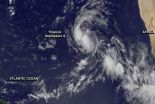(Press-News.org) Around 12,800 years ago, a sudden, catastrophic event plunged much of the Earth into a period of cold climatic conditions and drought. This drastic climate change—the Younger Dryas—coincided with the extinction of Pleistocene megafauna, such as the saber-tooth cats and the mastodon, and resulted in major declines in prehistoric human populations, including the termination of the Clovis culture.
With limited evidence, several rival theories have been proposed about the event that sparked this period, such as a collapse of the North American ice sheets, a major volcanic eruption, or a solar flare.
However, in a study published in The Journal of Geology, an international group of scientists analyzing existing and new evidence have determined a cosmic impact event, such as a comet or meteorite, to be the only plausible hypothesis to explain all the unusual occurrences at the onset of the Younger Dryas period.
Researchers from 21 universities in 6 countries believe the key to the mystery of the Big Freeze lies in nanodiamonds scattered across Europe, North America, and portions of South America, in a 50-million-square-kilometer area known as the Younger Dryas Boundary (YDB) field.
Microscopic nanodiamonds, melt-glass, carbon spherules, and other high-temperature materials are found in abundance throughout the YDB field, in a thin layer located only meters from the Earth's surface. Because these materials formed at temperatures in excess of 2200 degrees Celsius, the fact they are present together so near to the surface suggests they were likely created by a major extraterrestrial impact event.
In addition to providing support for the cosmic impact event hypothesis, the study also offers evidence to reject alternate hypotheses for the formation of the YDB nanodiamonds, such as by wildfires, volcanism, or meteoric flux.
The team's findings serve to settle the debate about the presence of nanodiamonds in the YDB field and challenge existing paradigms across multiple disciplines, including impact dynamics, archaeology, paleontology, limnology, and palynology.
INFORMATION:
C. R. Kinzie, et al., "Nanodiamond-Rich Layer across Three Continents Consistent with Major Cosmic Impact at 12,800 Cal BP," The Journal of Geology 2014, 122(5). http://www.jstor.org/stable/10.1086/677046
One of the oldest journals in geology, The Journal of Geology has since 1893 promoted the systematic philosophical and fundamental study of geology.
Microscopic diamonds suggest cosmic impact responsible for major period of climate change
Nanodiamonds provide strong support for Younger Dryas impact hypothesis
2014-09-11
ELSE PRESS RELEASES FROM THIS DATE:
Facebook posts reveal personality traits, but recent changes could make it harder to do so
2014-09-11
LAWRENCE — A study from the University of Kansas finds that people can accurately detect the personality traits of strangers through Facebook activity; however, changes to the social media site in the past three years could be making it harder to do so.
Researchers sampled 100 Facebook users, paralleling the demographics of the social networking site, and asked them to fill out a personality survey. A group of coders looked at each person's Facebook activity, 53 cues in all, to see whether certain personality types were more likely to do specific activities. The researchers ...
Sometimes, adolescents just can't resist
2014-09-11
Don't get mad the next time you catch your teenager texting when he promised to be studying.
He simply may not be able to resist.
A University of Iowa study found teenagers are far more sensitive than adults to the immediate effect or reward of their behaviors. The findings may help explain, for example, why the initial rush of texting may be more enticing for adolescents than the long-term payoff of studying.
"The rewards have a strong, perceptional draw and are more enticing to the teenager," says Jatin Vaidya, a professor of psychiatry at the UI and corresponding ...
Satellite view of newborn Atlantic Tropical Depression 6
2014-09-11
The sixth tropical depression of the Atlantic Ocean Hurricane Season formed in the Eastern Atlantic Ocean and NOAA's GOES-East satellite captured it.
A visible image of Tropical Depression 6 was taken by NOAA's GOES-East satellite at 7:45 a.m. EDT on September 11 as it developed. The image was created by NASA/NOAA's GOES Project at the NASA Goddard Space Flight Center in Greenbelt, Maryland.
In addition to using GOES imagery and data from other NOAA and NASA satellites, The National Hurricane Center also uses measurements from the Advanced Scatterometer or ASCAT instrument ...
NJIT researchers working to safeguard the shoreline
2014-09-11
An NJIT research team has estimated the total mass of oil that reached the Gulf of Mexico shore in the wake of the BP Deepwater Horizon blowout. It's the first time such an estimate was reported, and the study is published in the August issue of Environmental Science and Technology.
The researchers found that 22,000 tons of oil reached the Gulf shoreline in 2010. This finding will help officials determine the persistence of oil on the shore and identify potential harm to the ecosystem.
The study was conducted by the Center for Natural Resources Development and Protection ...
Penn Medicine bioethicists call for greater first-world response to Ebola outbreak
2014-09-11
PHILADELPHIA – Amid recent discussion about the Ebola crisis in West Africa, Penn Medicine physicians say that high-income countries like the United States have an obligation to help those affected by the outbreak and to advance research to fight the deadly disease — including in the context of randomized clinical trials of new drugs to combat the virus. The two new editorials, which will appear "online first" in JAMA on September 11th, are written by faculty members in the Perelman School of Medicine at the University of Pennsylvania and the Department of Social Science, ...
Unusual host preference of a moth species could be useful for biological control
2014-09-11
A team of Iranian researchers from the Rice Research Institute of Iran have discovered that Gynnodomorpha permixtana, a well-known moth species from Europe and Asia, has changed its host preferences in order to adjust to Iran's northern region environmental conditions. The importance of this adaptation for biological control of problematic weeds in rice fields and the biology of the moth on new host plant have been described in the open access journal Nota Lepidopterologica.
The larvae of G. permixtana have been so far reported to feed on the seeds and flowers of plant ...
Ebola paper demonstrates disease transmission rate
2014-09-11
Sept. 11, 2014 - New research from Arizona State University and the University of Tokyo that analyzes transmission rates of Ebola in West African countries shows how rapidly the disease is spreading.
Researchers Gerardo Chowell-Puente, ASU School of Human Evolution and Social Change Associate Professor, and Hiroshi Nishiura of the University of Tokyo found that transmission rates for each single case of Ebola consistently showed at least one new case of the disease being transmitted. Country-specific analysis of transmission rates in Liberia and Sierra Leone showed on ...
Some male scientists willing to forsake careers for family
2014-09-11
One third of men in academic science are willing to scale back their careers to focus on family life, according to researchers.
While traditional fatherhood roles may be shifting, men in the male-dominated field of academic science, such as physics and biology, face significant challenges in trying to balance work and family life, said Sarah Damaske, assistant professor of labor and employment relations and sociology, Penn State. The majority of men studied spoke of the pull of fatherhood and a desire to spend more time with children, yet they also acknowledged that academic ...
Not enough vitamin B1 can cause brain damage
2014-09-11
MAYWOOD, Ill – (Sept. 11, 2014) A deficiency of a single vitamin, B1 (thiamine), can cause a potentially fatal brain disorder called Wernicke encephalopathy.
Symptoms can include confusion, hallucinations, coma, loss of muscle coordination and vision problems such as double vision and involuntary eye movements. Untreated, the condition can lead to irreversible brain damage and death, according to neurologists at Loyola University Medical Center.
In the developed world, Wernicke encephalopathy typically occurs in people who have disorders such as alcoholism and anorexia ...
Investigators from Montefiore and Einstein to present data at 2014 ASTRO Meeting
2014-09-11
NEW YORK (September 10, 2014) – Members of the Department of Radiation Oncology at Montefiore Einstein Center for Cancer Care (MECCC) and Albert Einstein College of Medicine of Yeshiva University's NCI–designated Albert Einstein Cancer Center will present new study findings at the 56th Annual Meeting of the American Society for Radiation Oncology (ASTRO) revealing the impact socioeconomic status has on radiation treatment compliance, predictive indicators for clinical outcomes and on radiation therapy duration and dosing recommendations. ASTRO is being held September 14 ...
LAST 30 PRESS RELEASES:
Survey reveals ethical gaps slowing AI adoption in pediatric surgery
Stimulant ADHD medications work differently than thought
AI overestimates how smart people are, according to HSE economists
HSE researchers create genome-wide map of quadruplexes
Scientists boost cell "powerhouses" to burn more calories
Automatic label checking: The missing step in making reliable medical AI
Low daily alcohol intake linked to 50% heightened mouth cancer risk in India
American Meteorological Society announces Rick Spinrad as 2026 President-Elect
Biomass-based carbon capture spotlighted in newly released global climate webinar recording
Illuminating invisible nano pollutants: advanced bioimaging tracks the full journey of emerging nanoscale contaminants in living systems
How does age affect recovery from spinal cord injury?
Novel AI tool offers prognosis for patients with head and neck cancer
Fathers’ microplastic exposure tied to their children’s metabolic problems
Research validates laboratory model for studying high-grade serous ovarian cancer
SIR 2026 delivers transformative breakthroughs in minimally invasive medicine to improve patient care
Stem Cell Reports most downloaded papers of 2025 highlight the breadth and impact of stem cell research
Oxford-led study estimates NHS spends around 3% of its primary and secondary care budget on the health impacts of heat and cold in England
A researcher’s long quest leads to a smart composite breakthrough
Urban wild bees act as “microbial sensors” of city health.
New study finds where you live affects recovery after a hip fracture
Forecasting the impact of fully automated vehicle adoption on US road traffic injuries
Alcohol-related hospitalizations from 2016 to 2022
Semaglutide and hospitalizations in patients with obesity and established cardiovascular disease
Researchers ‘listen in’ to embryo-mother interactions during implantation using a culture system replicating the womb lining
How changing your diet could help save the world
How to make AI truly scalable and reliable for real-time traffic assignment?
Beyond fragmented markets: A new framework for efficient and stable ride-pooling
Can shape priors make road perception more reliable for autonomous driving?
AI tracks nearly 100 years of aging research, revealing key trends and gaps
Innovative techniques enable Italy’s first imaging of individual trapped atoms
[Press-News.org] Microscopic diamonds suggest cosmic impact responsible for major period of climate changeNanodiamonds provide strong support for Younger Dryas impact hypothesis


